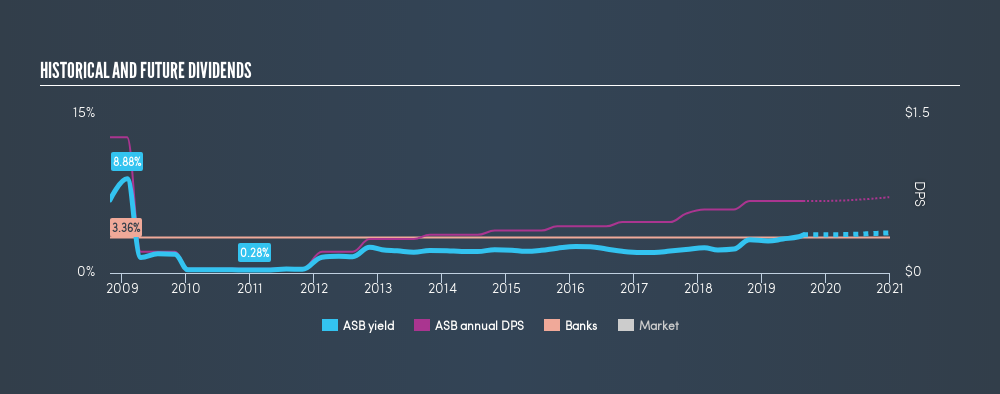- United States
- /
- Banks
- /
- NYSE:ASB
Is It Smart To Buy Associated Banc-Corp (NYSE:ASB) Before It Goes Ex-Dividend?

Some investors rely on dividends for growing their wealth, and if you're one of those dividend sleuths, you might be intrigued to know that Associated Banc-Corp (NYSE:ASB) is about to go ex-dividend in just 4 days. This means that investors who purchase shares on or after the 30th of August will not receive the dividend, which will be paid on the 16th of September.
Associated Banc-Corp's upcoming dividend is US$0.17 a share, following on from the last 12 months, when the company distributed a total of US$0.68 per share to shareholders. Based on the last year's worth of payments, Associated Banc-Corp stock has a trailing yield of around 3.6% on the current share price of $18.87. If you buy this business for its dividend, you should have an idea of whether Associated Banc-Corp's dividend is reliable and sustainable. That's why we should always check whether the dividend payments appear sustainable, and if the company is growing.
See our latest analysis for Associated Banc-Corp
If a company pays out more in dividends than it earned, then the dividend might become unsustainable - hardly an ideal situation. Associated Banc-Corp paid out a comfortable 33% of its profit last year.
Generally speaking, the lower a company's payout ratios, the more resilient its dividend usually is.
Click here to see the company's payout ratio, plus analyst estimates of its future dividends.

Have Earnings And Dividends Been Growing?
Businesses with strong growth prospects usually make the best dividend payers, because it's easier to grow dividends when earnings per share are improving. If earnings fall far enough, the company could be forced to cut its dividend. Fortunately for readers, Associated Banc-Corp's earnings per share have been growing at 13% a year for the past five years.
Another key way to measure a company's dividend prospects is by measuring its historical rate of dividend growth. Associated Banc-Corp has seen its dividend decline 6.1% per annum on average over the past 10 years, which is not great to see. Associated Banc-Corp is a rare case where dividends have been decreasing at the same time as earnings per share have been improving. It's unusual to see, and could point to unstable conditions in the core business, or more rarely an intensified focus on reinvesting profits.
Final Takeaway
Has Associated Banc-Corp got what it takes to maintain its dividend payments? When companies are growing rapidly and retaining a majority of the profits within the business, it's usually a sign that reinvesting earnings creates more value than paying dividends to shareholders. This strategy can add significant value to shareholders over the long term - as long as it's done without issuing too many new shares. Overall, Associated Banc-Corp looks like a promising dividend stock in this analysis, and we think it would be worth investigating further.
Ever wonder what the future holds for Associated Banc-Corp? See what the eight analysts we track are forecasting, with this visualisation of its historical and future estimated earnings and cash flow
A common investment mistake is buying the first interesting stock you see. Here you can find a list of promising dividend stocks with a greater than 2% yield and an upcoming dividend.
We aim to bring you long-term focused research analysis driven by fundamental data. Note that our analysis may not factor in the latest price-sensitive company announcements or qualitative material.
If you spot an error that warrants correction, please contact the editor at editorial-team@simplywallst.com. This article by Simply Wall St is general in nature. It does not constitute a recommendation to buy or sell any stock, and does not take account of your objectives, or your financial situation. Simply Wall St has no position in the stocks mentioned. Thank you for reading.
About NYSE:ASB
Associated Banc-Corp
A bank holding company, provides various banking and nonbanking products and services to individuals and businesses in Wisconsin, Illinois, Missouri, and Minnesota.
Flawless balance sheet with reasonable growth potential.
Similar Companies
Market Insights
Community Narratives



